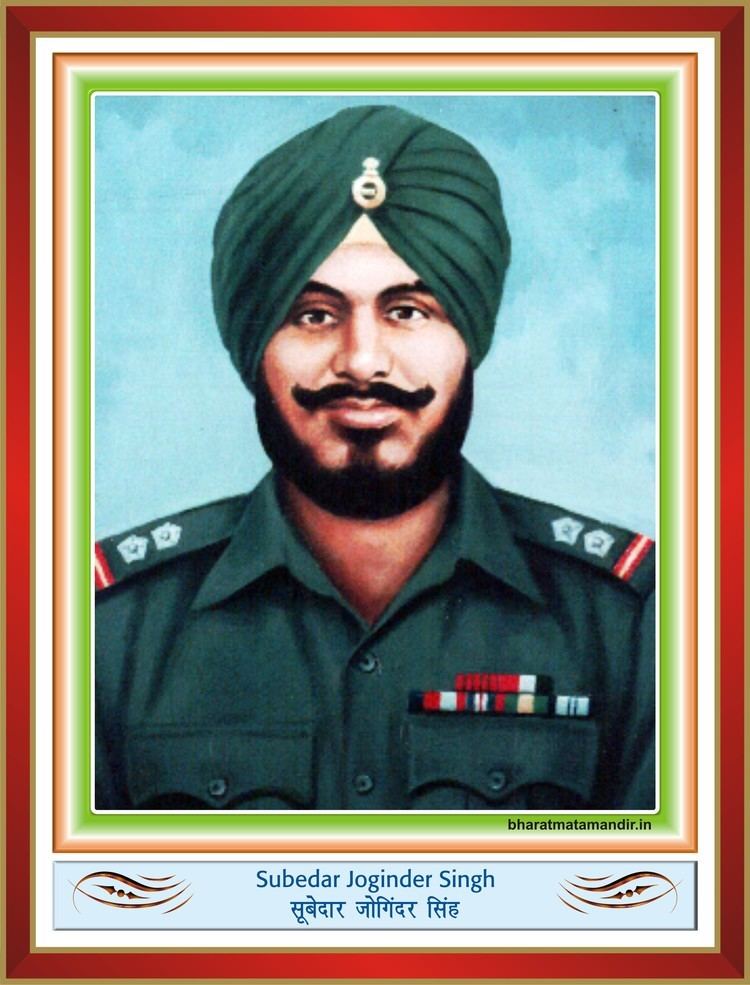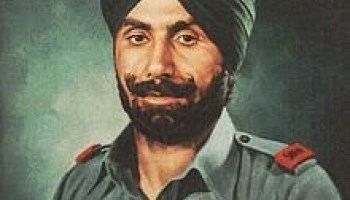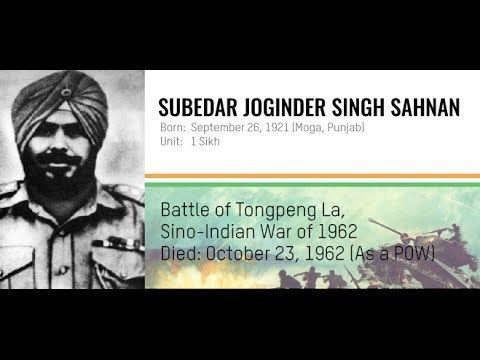Years of service 1936-1962 Name Joginder Sahnan Allegiance British Raj, India | Battles and wars Sino-Indian War Died October 23, 1962 | |
 | ||
Service/branch British Indian Army Indian Army | ||
Subedar Joginder Singh Biography In Punjabi || by live punjabi
Subedar Joginder Singh Sahnan, PVC (26 September 1921 – 23 October 1962), a Saini Sikh, born in Moga, Punjab (British India), was a Subedar in the Indian Army who was awarded the distinguished Param Vir Chakra, the highest wartime gallantry award of the Indian Army. On 28 September 1936, he was enrolled in the 1 Sikh Regiment. His father, Sher Singh Sahnan, belonged to an agricultural Saini Sikh family which had relocated to village Mahla Kalan near Moga from village Munaka of district Hoshiarpur. His mother's name was Bibi Krishan Kaur Bhela. He married Bibi Gurdyal Kaur Banga, who was from a Saini family of village Kothay Rara Singh near Kot Kapura. He went to primary school in village Nathu Ala and to village Daroli for his middle school.
Contents
- Subedar Joginder Singh Biography In Punjabi by live punjabi
- Military action
- Citation
- Memorial in Moga Punjab
- Other honours
- In popular media
- References

Military action

During the 1962 Sino-Indian War, Subedar Joginder Singh commanded a platoon in the Tawang sector of NEFA (North East Frontier Agency). While holding a defensive position on a ridge in Tongpeng La area on Bum La axis, the platoon noticed heavy Chinese concentration opposite Bum La across the McMohan Line on October 20. This was indeed a preparatory to the Chinese advance on Bum La axis on October 23.

At 0530 hours on October 23, the Chinese launched a heavy attack on the Bum La axis. The intention was to achieve a breakthrough to Tawang. The Chinese attacked the ridge in three waves, each about 200 strong. The attack was supported by artillery and mortar fire, besides other weapons. The fierce resistance of the Sikh platoon, however, compelled the Chinese to fall back with heavy losses. But they regrouped quickly and launched a fresh attack under the cover of an artillery barrage.

Subedar Joginder Singh and his platoon stood firm like a rock before the advancing enemy. In this fierce action, the platoon lost half of its men but not the will to fight. Subedar Joginder Singh, despite a thigh wound, refused evacuation. His platoon also refused to yield any ground to the Chinese. The last wave of the Chinese attack, which was more determined and more forceful followed next. Now the platoon had very few men left to fight. Subedar Joginder Singh, therefore, manned a light machine gun and killed a large number of enemies, about 52 men.
But he could not stem the tide of the Chinese advance single-handedly. The Chinese Army continued advancing with little concern for the casualties. By now all ammunition with the platoon had been exhausted. When the situation became desperate, Subedar Joginder Singh and his men emerged from their position with fixed bayonets, shouting the Sikh battle cry, "Bole So Nihal, Sat Shiri Akaal". They fell upon the advancing Chinese and bayoneted many to death.
Finally better weapons and numerical superiority of the Chinese prevailed and Subedar Singh was captured after this epic battle. He died from his wounds and frostbite as a PoW in Chinese custody. For his inspiring leadership, steadfast courage and devotion to duty beyond all odds, Subedar Joginder Singh was awarded the highest wartime gallantry medal, the Param Vir Chakra, posthumously.
Citation
The Param Vir Chakra citation on the Official Indian Army Website reads as follows:
SUBEDAR JOGINDER SINGH
Subedar Joginder Singh was the commander of a platoon of the Sikh Regiment holding a defensive position at a ridge near Tongpen La in NEFA. At 0530 hours on 23 October 1962, the Chinese opened a very heavy attack on the Bumla axis with the intention of breaking through to Towang. The leading battalion of the enemy attacked the ridge in three waves, each about 200 strong. Subedar Joginder Singh and his men mowed down the first wave, and the enemy was temporarily halted by the heavy losses it suffered. With in a few minutes, a second wave came over and was dealt with similarly. But the platoon had, by then, lost half its men.
Subedar Joginder Singh was wounded in the thigh but refused to be evacuated. Under his inspiring leadership the platoon stubbornly held its ground and would not withdraw.
Meanwhile the position was attacked for the third time. Subedar Joginder Singh himself manned a light machine-gun and shot down a number of the enemy. The Chinese however continued to advance despite heavy losses. When the situation became untenable Subedar Joginder Singh and the few men that were left in the position fixed bayonets and charged the advancing Chinese, bayoneting a number of them before he and his comrades were overpowered. Throughout this action, Subedar joginder Singh displayed devotion to duty, inspiring leadership and bravery of the highest order.
Memorial in Moga, Punjab
Subedar Joginder Singh Sahnan (PVC) received highest civilian commemoration in his native town of Moga in 2006 when his statue adorned in battle fatigue was inaugurated near district DC office.
Other honours
The shipping corporation of India has honoured this great man by naming one of their vessels Subedar Joginder Singh PVC.
In popular media
A Punjabi movie is also going to be released next year which will be first ever biopic of any Param Vir Chakra awardee.
